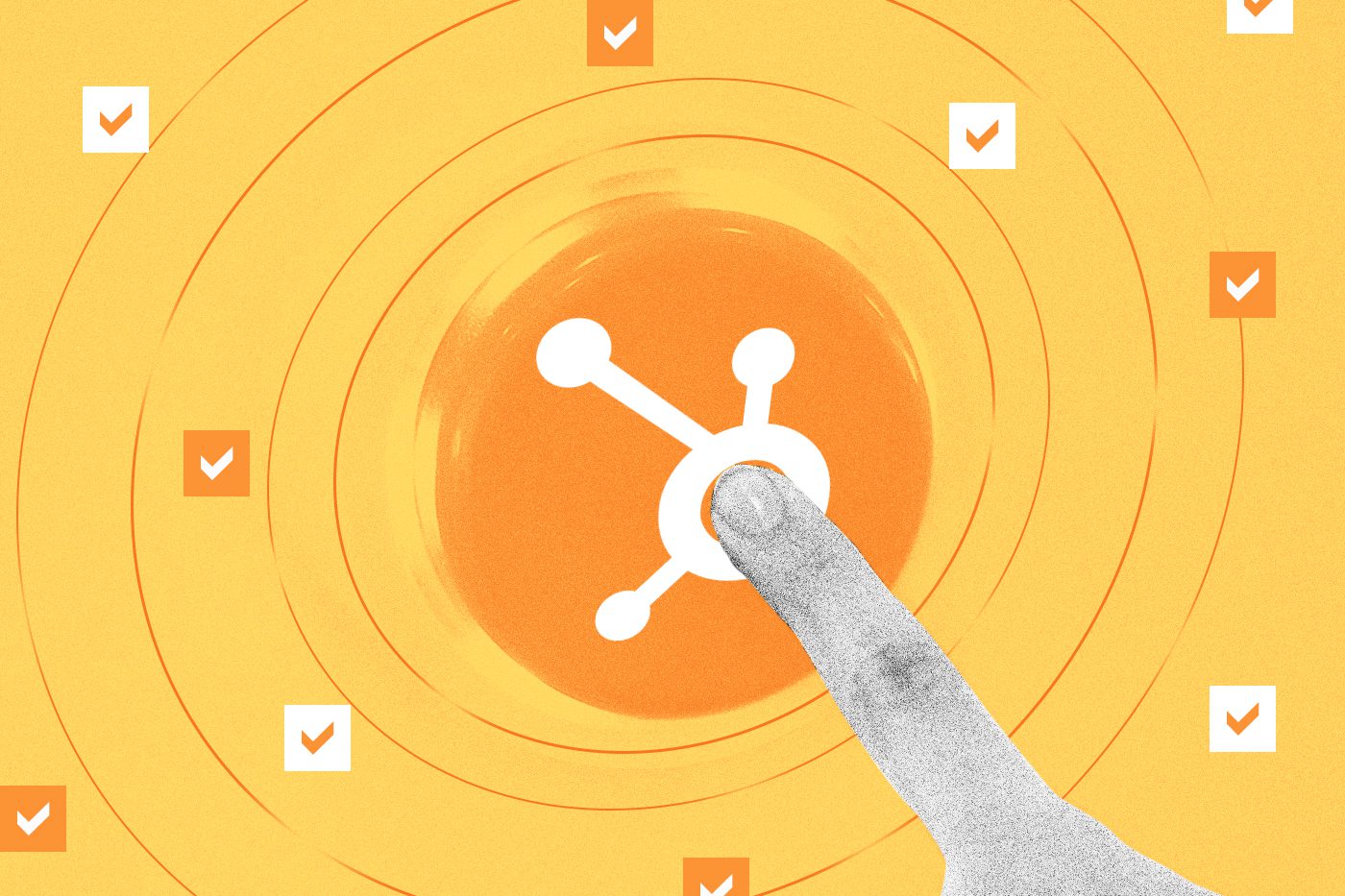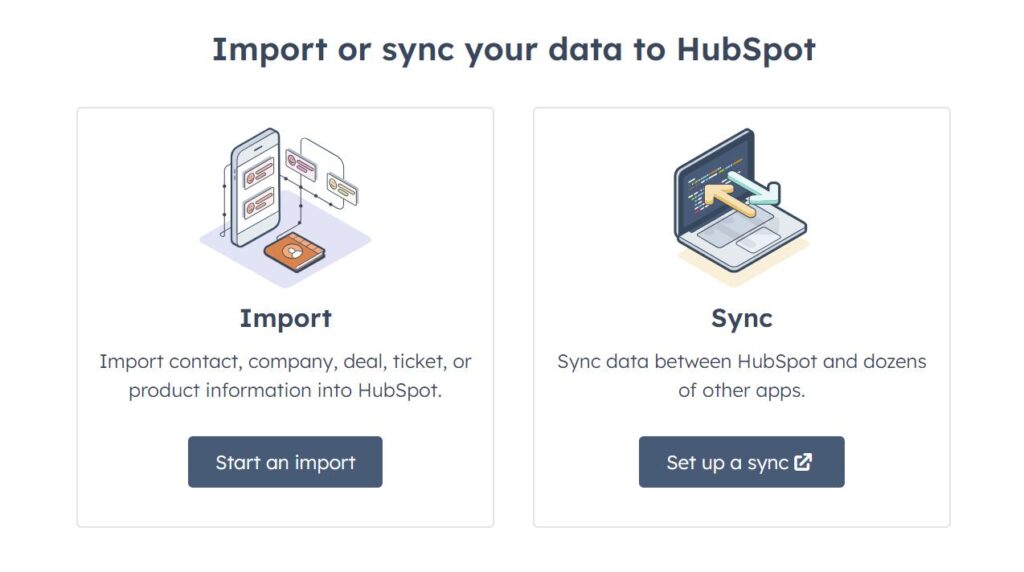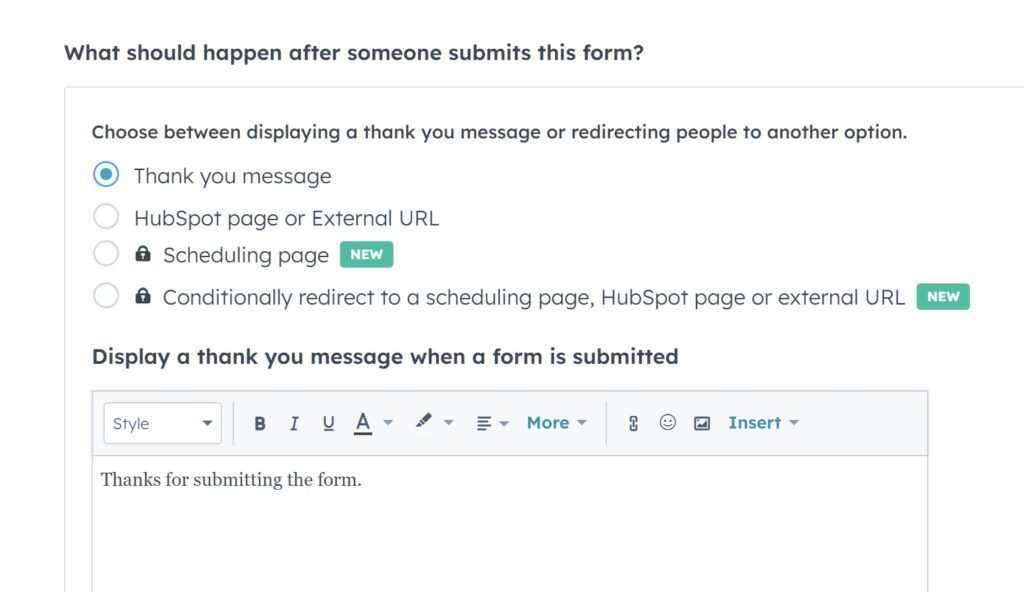HubSpot Implementation: Step-by-Step
- What are "Hubs" in HubSpot?
- HubSpot implementation in 5 Steps
- 1. Create your account & connect your email
- 2. Import your contacts
- 3. Define deal stages
- 4. Optional: install the HubSpot tracking code
- 5. Set Up Lead Capture Forms
- HubSpot Implementation Checklist
- FAQs about HubSpot implementation
- Is HubSpot easy to implement?
- What are the main benefits of HubSpot?
- How long does a HubSpot implementation take?
- Is HubSpot just a CRM?
- Let us help you get started with HubSpot faster
Is your business, nonprofit, or professional organization struggling to keep up with leads or scattered customer data? HubSpot’s suite of tools is designed to solve exactly these types of challenges. By aligning your sales process, marketing efforts, and customer interactions with HubSpot, you’ll unlock the potential for growth. This guide provides a clear roadmap for your initial HubSpot implementation journey.

What are “Hubs” in HubSpot?
HubSpot’s power lies in its organization around “Hubs.” Each Hub is a collection of software tools specifically designed to support different areas of your business:
- Marketing Hub: Attracting visitors and converting leads with tools for blogging, social media, SEO, landing pages, and more.
- Sales Hub: Facilitates managing deal pipelines, tracking customer interactions, automating tasks, and closing deals.
- Service Hub: Streamlines customer support through ticketing systems, knowledge bases, surveys, and live chat features.
- CMS Hub: Provides an easy-to-use content management system for building and maintaining your website.
- Operations Hub: Connects your various apps, cleans and manages customer data, and automates business processes across teams.
Why HubSpot?
HubSpot’s real advantage is how it can capture and organize rich customer data throughout the sales process. Every interaction, from website visits to email opens, is recorded within the CRM. This provides the foundation for creating highly segmented audiences.
Here’s why segmentation matters:
- Personalized Messaging: Instead of generic blasts, you can deliver tailored content, offers, and communications directly addressing the specific needs of a well-defined audience segment.
- Higher Engagement: Delivering relevant content leads to improved open and click-through rates in your email campaigns and nurtures prospects more effectively.
- Optimized Sales Efforts: Sales teams can focus their outreach on the most promising leads, increasing conversions and efficiency.
HubSpot implementation in 5 Steps
Ready to get started in HubSpot? Here’s how you get set up the first time (for free, too):
1. Create your account & connect your email
Start your journey with HubSpot for free by visiting https://www.hubspot.com/ and clicking on “Get started free”. You’ll be guided through a few simple steps to set up your account. HubSpot offers three convenient ways to sign up, including Google and Apple ID.
Once you have an account, your first step should be to connect your business’ email (Gmail, Outlook, etc.) to it. This brings all your customer conversations directly into HubSpot, and more crucially, empowers you to send email campaigns, track engagement, and even use personalized email templates – all from within HubSpot. Make sure to connect your domain so that all your content is housed on your brand domain.
2. Import your contacts
Transfer your existing contact list from spreadsheets (CSV files) or other CRMs. HubSpot offers clear guides on how to format and import your data. HubSpot’s knowledge base has detailed guides on the entire import process:
- https://knowledge.hubspot.com/import-and-export/set-up-your-import-file
- https://knowledge.hubspot.com/import-and-export/import-objects

3. Define deal stages
To really get the most out of HubSpot, you should make sure you’re set up to track leads and sales. This starts when you define your deal stages. Map out the various stages in your sales pipeline (e.g., Prospect, Qualified Lead, Negotiation, etc.). This helps visualize and track where your deals are at in the sales process. Here’s a few common examples:
- Prospect
- Qualified Lead
- Meeting Scheduled
- Proposal Sent
- Negotiation
- Closed Won/Closed Lost

4. Optional: install the HubSpot tracking code
Add this code snippet to your website to track visitor behavior and gain insights. You can find your code inside your HubSpot account when you navigate to the tracking code section (check your settings).
How you add the code to your site will depend on how your website is built. But if you’re using a CMS like WordPress, most platforms have places to add header/footer code. Paste it there!
![]()
5. Set Up Lead Capture Forms
A great HubSpot implementation focuses on making the most of its top tools. Lead capture forms are a huge advantage of using HubSpot. Forms are essential for converting website visitors into identifiable leads, and HubSpot makes it fast, easy, and beautiful. Start with HubSpot’s form builder to easily create forms for embedding on your website. Use their powerful tools to customize the forms for your brand and messaging. This allows you to collect leads and their information automatically.

HubSpot Implementation Checklist
Phase 1: Initial Setup
- [ ] Create your HubSpot account (Deadline: //__)
- [ ] Connect your business email (Deadline: //__)
- [ ] Import contacts from existing sources (Deadline: //__)
- [ ] Create custom properties (Deadline: //__)
- [ ] Define deal stages in your sales pipeline (Deadline: //__)
- [ ] Invite team members and set permissions (Deadline: //__)
Phase 2: Website & Lead Generation
- [ ] Install HubSpot tracking code on your website (Deadline: //__)
- [ ] Build and embed lead capture forms (Deadline: //__)
- [ ] Set up basic marketing automation workflows (e.g., welcome emails) (Deadline: //__)
- [ ] Connect your social media accounts (Optional) (Deadline: //__)
Phase 3: Nurturing & Sales Enablement
- [ ] Create segmented contact lists (Deadline: //__)
- [ ] Develop email marketing campaigns (Deadline: //__)
- [ ] Set up meeting links for sales reps (Deadline: //__)
- [ ] Explore sales tools (templates, sequences, etc.) (Deadline: //__)
Phase 4: Customer Service (If using Service Hub)
- [ ] Set up a knowledge base (Deadline: //__)
- [ ] Create ticket pipelines (Deadline: //__)
- [ ] Implement live chat or chatbots (Deadline: //__)
- [ ] Develop customer feedback surveys (Deadline: //__)
Phase 5: Reporting & Optimization
- [ ] Define key metrics and KPIs to track (Deadline: //__)
- [ ] Create custom dashboards (Deadline: //__)
- [ ] Regularly review your analytics (Set a recurring weekly/monthly reminder)
FAQs about HubSpot implementation
Implementing a new piece of technology can be a significant investment, especially at nonprofits where staff are always trying to do more with less. Below are the answers to some frequently-asked questions that can help you decide if HubSpot is right for your organization.
Is HubSpot easy to implement?
HubSpot is generally considered to be a user-friendly CRM (customer relationship management) system, especially for small- to medium-sized nonprofits and museums. Here’s a breakdown of what makes it easy to implement:
- Freemium model: HubSpot offers a free tier with the most important CRM functionalities, allowing you to try it out before committing.
- Intuitive interface: The platform is designed to be user-friendly with a clean and easy-to-navigate interface.
- Onboarding resources: HubSpot provides a wealth of resources, including tutorials, guides, and certifications, to help you get started.
- Staged implementation: You can start with the basic features and gradually add more complexity as your needs evolve.
What are the main benefits of HubSpot?
HubSpot has several benefits that make it a good fit for organizations like nonprofits and museums, but it comes down to a few key features: HubSpot consolidates marketing, sales, customer service, and content management tools into a single platform. This eliminates the need for multiple software subscriptions and simplifies workflows, allowing your teams to focus on relationships with people, not technology.
In addition, HubSpot offers a variety of tools to attract visitors, convert leads, and nurture them into customers or donors. This includes SEO tools, social media management, email marketing, and landing page creation. It allows you to automate repetitive marketing tasks, such as email nurturing campaigns and social media posting. This frees up your marketing team’s time to focus on more strategic initiatives.
Finally, HubSpot is designed to be user-friendly, even for organizations without a lot of technical expertise. The platform offers a clean interface, extensive onboarding resources, and a free tier to allow for easy exploration.
How long does a HubSpot implementation take?
HubSpot implementation timelines can vary depending on several factors, but typically range from a few days to several months, with most implementations taking about a week in our experience.
Remember, these are just estimates. It’s always best to discuss your specific requirements with a Gold HubSpot Partner like Big Sea. For examples of how Big Sea and HubSpot can work together to support the specific needs of your organization, check out these case studies where we go into detail about how three very different nonprofits have implemented HubSpot.
Is HubSpot just a CRM?
Most CRM services excel at managing customer interactions and data, but they don’t encompass all aspects of the customer lifecycle. HubSpot’s CRP, on the other hand, expands on the basic CRM functionalities and incorporates tools for marketing, sales, customer service, and content management, all within a single platform. Centralizing multiple services into one platform is what differentiates HubSpot from other CRM services.
Let us help you get started with HubSpot faster
We at Big Sea love to work with organizations that are dedicated to a cause. And with over 11 years of experience partnering with all kinds of organizations, including nonprofits and museums, Big Sea can help you get the most out of your HubSpot subscription. Reach out to us today to get started.

